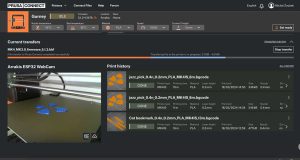The concept of self-driving cars is nothing new. Google has been testing them for years. The startup company, Local Motors, has taken the idea into a whole different dimension.
Their self-driving vehicle, dubbed Olli, is a minibus with a 12-person capacity, a prototype that can be summoned to a potential rider with a mobile app, just like Uber. But what makes Olli special is that it can be “printed” by a specialized 3D printer in hours.
Local Motors is taking Olli on the road in more ways than one, branching out from Washington D.C., to Las Vegas, and Florida, then abroad to many other cities around the world, including Copenhagen, Canberra, and Berlin, one of the world’s centers of automotive technology.
Google is still testing their self-driving cars and expect to be in testing for years to come. Local Motors would like to beat them onto the road, as soon as the technology is approved by law.
Printed Transport
Olli is just one bus. The University of Michigan intends to make a much more expansive project for their North Campus. Their plan is to print a variety of low-speed electric “SmartCarts” to take both students and faculty wherever they need to go on campus.
Also likened to Uber, this fleet of SmartCarts is intended to drive its passengers to their on-campus destinations, completely free of the need for drivers. The North Campus is considered by many to be an ideal testing ground, because of its relatively confined space, at least in comparison to a major city. Should the project be implemented, it will be a valuable source of data in determining just how autonomous on-demand transportation systems will work on a larger scale.
U-M has even received some support from Local Motors, the creators of Olli, in the form of a 3D-printed vehicle. It is to be the first of three vehicles printed for the university. Researchers will spend a year programming the cars to work on their own, then creating a mobile app that users can employ to call up one of the vehicles and request a ride to their destination.
The SmartCart is run by a simple golf cart motor, but thanks to Local Motors, the body is entirely printed from the same plastic used to create Lego bricks, with fiber woven in to give it added durability. Because it’s a printed vehicle, if the researchers at U-M need to make any changes, all they need to do is inform Local Motors, who can program the changes into their printer, creating a new component or a new iteration of the car within hours.
Such a relatively rapid creative process would simply be impossible without 3D printing. Between Local Motors and the University of Michigan, the research team hopes to launch a pilot program on a portion of the campus in late 2016 or early 2017. It may well be the genesis of a whole new system of transportation, not only for the U-M campus, but for cities across the country and around the world.
Printed Prosthetics
Of course, printed technology goes far beyond vehicles, even autonomous ones. 3D printing technology has also made great inroads into prosthetic design, giving those who suffer the loss of a limb new hope. Hundreds of thousands of amputations are performed each year in the United States, and prosthetics can be very expensive, costing up to $50,000 in some cases.
Furthermore, each limb has to be created specifically for the person who will wear it, since everyone has a unique body shape. This means even if one has the money to purchase a prosthetic, it can take months to finally receive it. 3D printing can address both of those problems with ease.
As the popularity of 3D printers grow, they also drop in price, to a level that even small businesses can afford one. It’s not inconceivable for a medical technician to one day simply give a patient the specifications for their new prosthetic, then have it printed at a local shop. One day, they may even be able to get an email from their doctor and print out a new prosthetic from the comfort of their own homes.
A Major Printing Project
Perhaps as a sign that 3D printing is not going anywhere any time soon, a 12-year-old boy has made a bit of a stir by starting a GoFundMe campaign to acquire his own 3D printer. Because the versatility of the printer, he intends to cut out the middleman and create small manufactured items at a low price, enabling him to sell lower than more traditional stores. Recognizing that the right printer can produce any number of objects, he plans to offer everything from mundane items like pens, to toys, to very practical tools.
Should he achieve his goal, he plans to spread the use of 3D printing, giving 10% of his profit to schools and charities, and teaching others how to use the software and tools he plans to use. Like Olli, he may well end up being just the beginning of a major trend.
Subscribe to our Newsletter
3DPResso is a weekly newsletter that links to the most exciting global stories from the 3D printing and additive manufacturing industry.




























